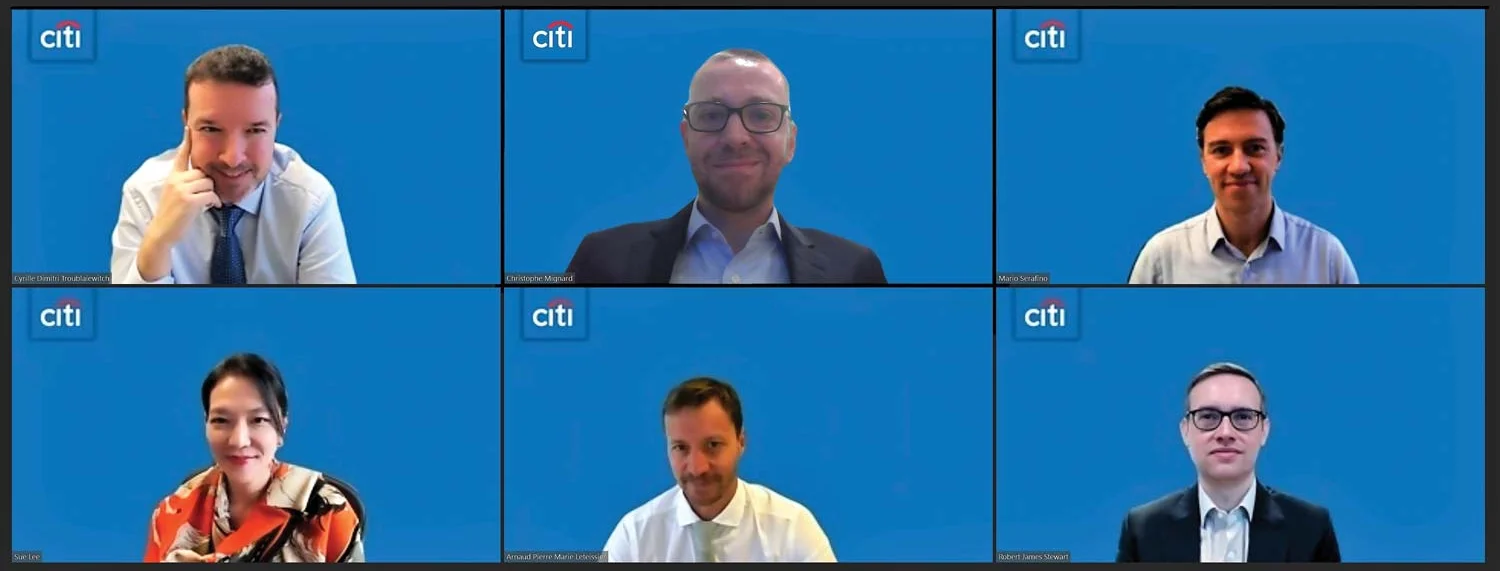
Equity derivatives house of the year: Citi
Risk Awards 2023: Bank’s novel approach to volatility proved a knockout with clients

When the three-year bull run came to a screeching halt in 2022, it also marked the end of a long-held norm within the markets: that volatility rises as spot falls. While the S&P 500 shed 20% over the course of the year, index volatility remained surprisingly subdued, rendering many traditional volatility hedges inadequate. At the same time, the wild swings in single name stocks that occurred around earnings releases proved tricky to navigate.
Equity derivatives businesses therefore needed to be nimble, and Citi proved adept at finding the right products for these curious times. The bank dominated the market for volatility knockout options (VKOs) and sold $30 billion notional of these low-cost hedges, which paid holders multiple times their premiums.
Citi also enhanced its reputation for innovation. A machine learning model that forecasts the shape of options volatility surfaces on single names gave US flow traders an edge in navigating earnings shocks; and the bank brought in third-party intraday fixing for multi-leg index contracts and introduced a variation on the popular dispersion trade that allows it to offload its correlation exposure only in times of stress.
“The standout is its capacity to bring new products or adapt to new situations,” says one hedge fund client. “It’s by far the most versatile and nimble when it comes to approaching new situations.”

“With the market so volatile, no-one really spent time innovating,” says another buy-side client. “It’s one of the things that makes Citi stand out.”
Quentin Andre, the bank’s global head of derivatives sales, suggests it was less about formulating new ideas and rapidly deploying them, and more a matter of long-term preparation. “If you start looking at markets and debating what you create on the spot, you get nowhere,” he says. “A lot of the things we ended up implementing and helping clients to implement with us, whether on the systematic index side, they’ve actually been with us for years and had live track records.”
Activity in Citi’s quantitative investment strategies business has doubled since 2018. Customised dispersion strategies, which aim to monetise the richest distribution of implied correlation, delivered returns of up to 20% for clients. Vix volatility carry strategies delivered returns of up to 70%, amid limited demand for implied volatility and a flattening of the S&P skew (the difference between out-of-the-money and at-the-money options). In total, the bank traded around $15 million of vega notional on the two sets of strategies.
Fater Belbachir, Citi’s global head of equities, says dexterity is critical to the bank’s success. “Being able to warehouse the changing cycles, given the speed with which cycles are changing now, is key,” he says. “Things are changing a lot faster than they used to and we have to be very cautious of that dynamic.”
One of its clients agrees that the bank’s rapid response times set it apart from the competition: “Most banks reply in one or two weeks. With Citi, it’s usually 24 hours and you’ll get 80% of the answer, which really moves the discussion forward.”
Knockout win
Inflation, rising interest rates and Russia’s invasion of Ukraine all contributed to a 20% sell-off on the S&P 500 in 2022. However, volatility hardly budged, realising in the low- to mid-20s for much of the year. It was a far cry from the sell-offs of 2008 and 2020, when volatility realised at more than 50.
Citi was quick to spy an opportunity for a longstanding yet speculative product – the VKO.
These options, which are a relatively common feature of the exotics toolkit, have a patchy history of hedging major selloffs. A typical structure involves an investor buying a put option struck at 90% to 95% of spot, with a volatility barrier of between 30 and 40. If volatility goes any higher, the contract expires worthless; otherwise, the contract pays out in the same manner as a vanilla option.
The big selling point is the discount. VKO premiums can be just a tenth of those for vanilla options. In 2022, the trades paid off in spades, with lucky holders raking in seven times the initial premium – and sometimes more.
Citi traders ramped up their efforts to sell the products in late 2021 after noticing that the skew for the S&P 500 was realising well below implied levels.
“Right from the get-go, the team were very aware that a product which really suited the market was the VKO, because we kept having these selloffs and volatility was being dulled,” says David Haldane, Citi’s global head of derivatives trading.

He puts those dynamics down to the impact of a spate of hedge fund deleveraging in late 2021 and dealers hedging their autocallable bond inventory: “It created the perfect environment for a directional put that had a focus on variance to work.”
Citi traded more than $30 billion notional of the instruments – many times the volume of previous years – with around 40 clients. It was able to meet the demand thanks to a sharp focus on monetising client inventory as the skew flattened and options premiums increased. This generated heavy in-and-out trading and ensured the bank only held a fraction of traded notional at any time.
“On the trading side, it’s still a relatively complex product and we don’t want to warehouse it all,” says Guillaume Flamarion, co-head of Citi’s multi-asset group for the Americas. “So the fact we started to have two-way flow on those was a bit of a win-win. It’s not something we can predict, but it was one of the client solutions we found to be the most attractive at the time and we actively pushed.”
Citi’s strength in the products did not go unnoticed. “It was massive in VKOs,” says a buy-side client. “It came up with different types of structures, not just to make money, but to create something that would actually work.”
Variations included VKOs referencing other equity indexes as well as fixed-income exchange traded funds. Forward-starting VKOs helped clients trade views around macro announcements, while capped and floored versions worked well after October’s surprisingly low US inflation figures triggered a 6% market rally, thereby taking the sheen off standard versions of the product.
“With S&P skew flattening, VKOs became less attractive than they were earlier in the year,” says Flamarion. “One of the reasons why we came with those tweaks was to keep the cost efficiency and attractiveness to clients.”
The evolutionary approach meant VKOs continued to deliver strong returns even as lower spot prices and flatter skew made for less attractive entry levels. “We have plenty of examples where clients entered at a worse time than they would have at the back end of 2021,” says Flamarion. “But they are still multiplying their premium by three to five times because skew kept getting lower and volatility was not realising.”
Flow-bots
Though index volatility was subdued, the stock prices for certain companies whipsawed on earnings shocks. Shares in Facebook owner Meta sank 20% on February 2 after a disappointing earnings statement. Just two days later, a positive earnings statement caused Amazon’s shares to rise by 13%.
Hedging these kinds of surprises can be hazardous for options traders, who must take a view on how a variety of scenarios might affect volatility. Traders use the implied volatility term structure to make forecasts, but this only reflects the consensus view and fails to account for surprises.
In early 2022, Citi’s US flow desk began using a machine learning model that forecasts the shape of implied volatility surfaces under multiple scenarios. The volatility event impact model, or Veim, which was developed in-house by the bank’s quants, aims to predict how sensitivities – such as delta and gamma as well as the overall P&L of the single-name book –respond to different spot moves.

The timing was fortuitous.
“It’s been a good year to test it, as where the machine learning model outperforms the traditional approach is for those larger moves,” says Anissa Dhouibi, Citi’s global head of equities quantitative analysis, who led the project.
On January 27 of last year, shares in chipmaker Intel shed 7% after weak earnings. A traditional local implied volatility approach predicted a downward shift of the whole volatility surface in response to the spot move. Veim, however, forecast a steepening of the volatility smile – an outcome that proved correct.
Citi traders have described the tool as a “game-changer”.
“It’s not something traders could do manually or in their heads, certainly on that number of stocks,” says Dhouibi.
The model is trained on a universe of 800 names. During quarterly earnings seasons, it produces forecasts for up to 40 of these names that have earnings announcements coming up.
“If you were a trader trading one or two names, maybe you could do something like that in your head,” adds Dhouibi. “But we’re talking hundreds of names and around 30 that might have earnings, with different scenarios that are really looking at the full shape of the vol surface.”
Haldane says the tool has been pivotal for closing the gap in US flow between Citi and its larger peers – an area in which the bank had been struggling.
Dispersion development
As markets began their jittery slide, dealers started to fret about a potential build-up of exotic risk stemming from retail structured products. Instruments such as autocallable bonds had been popular yield-enhancement plays through the bull market, but now lacked the upside triggers to knock out, causing exposures to pile up on dealers’ balance sheets.
One of the most acute concerns remains the structurally short correlation exposure stemming from so-called worst-of autocallables, which use correlations between indexes or single stocks to bolster payoffs. Dealers typically offload part of this risk to sophisticated investors via dispersion trades. Citi sought to widen the appeal of these trades.
Holders of index dispersion contracts are exposed to an idiosyncratic risk resulting from different time zones. A dispersion trade referencing the S&P 500 and the EuroStoxx 50 would mean pricing on the US leg being fixed 4.5 hours after the fixing in Europe. This would leave participants exposed to any large moves in the S&P index after the European close. Dealers typically use five-day returns to improve the accuracy of the correlation measure, though this introduces more than 22 hours of mismatch.
Alternatively, banks can use a synchronous observation, which typically involves fixing the S&P leg at the European close. This delivers a purer correlation exposure, resulting in a pricing improvement of around 3 basis points for the buyer.
Citi was not alone in pushing synchronous fixings, but it added a new layer of transparency. While other dealers used their own intraday infrastructure to provide proprietary fixings, Citi turned to third-party calculation agent Merqube.
The fact we’ve been able to do the calculation with Merqube allows us to reach out to more clients
Guillaume Flamarion, Citi
“People have been doing this for a long time in their own way,” says Flamarion. “But the fact we’ve been able to do the calculation with Merqube allows us to reach out to more clients as opposed to using the internal intraday fixing calculation. We do both, but this allows us to expand in a much quicker way.”
Merqube computes S&P fixings at the London and Tokyo closes, as well as Nasdaq and Russell fixings at the London close, using a time-weighted average price. Merqube’s co-founder and CEO, Vinit Srivastava, sees broad scope for these benchmarks.
“We’re exploring all the different possibilities,” he says. “There are other use cases for this – for example, if you have multi-asset futures-based products in Europe or Asia and the US, you want all of those to settle at the same time. It’s a much more accurate picture of what your NAV is.”
Citi traded around $60 million vega notional using Merqube fixings. Although the bank enjoyed an early exclusivity over the index, the contract was designed to allow other dealers to use the fixings.
“In case clients want to novate later on, or make sure other people are quoting because it’s part of their process, we make sure that’s the case,” says Flamarion. “If we only go to a third party and make it exclusive, we don’t really solve the problem. We make sure that if clients really want it, they can also get support from someone else.”
Citi’s ongoing attempts to recycle its own correlation exposure saw the bank develop a new form of dispersion trade. Traditional geometric dispersion trades involve banks passing on the full correlation risk to clients. Although this allows a bank to avoid potentially crippling exposures in market stress – when correlation moves to one – it misses out on potentially lucrative carry opportunities during normal conditions.
Working with some key clients, Citi traded versions that cover only the left tail of its short correlation risk. This means exposure is hedged in the event of market stress but allows the bank to benefit from the carry during normal times.
Although hedge funds typically avoid trades that involve them writing protection for extreme events, Citi’s clients welcomed the pickup the bank’s version offered.
“Typically, it’s the opposite of the trade we normally do, but it’s struck at a high level,” says a hedge fund client. “We ran a bunch of simulations and were comforted that the risk was remote, so we were comfortable underwriting.”
Only users who have a paid subscription or are part of a corporate subscription are able to print or copy content.
To access these options, along with all other subscription benefits, please contact info@risk.net or view our subscription options here: http://subscriptions.risk.net/subscribe
You are currently unable to print this content. Please contact info@risk.net to find out more.
You are currently unable to copy this content. Please contact info@risk.net to find out more.
Copyright Infopro Digital Limited. All rights reserved.
As outlined in our terms and conditions, https://www.infopro-digital.com/terms-and-conditions/subscriptions/ (point 2.4), printing is limited to a single copy.
If you would like to purchase additional rights please email info@risk.net
Copyright Infopro Digital Limited. All rights reserved.
You may share this content using our article tools. As outlined in our terms and conditions, https://www.infopro-digital.com/terms-and-conditions/subscriptions/ (clause 2.4), an Authorised User may only make one copy of the materials for their own personal use. You must also comply with the restrictions in clause 2.5.
If you would like to purchase additional rights please email info@risk.net
More on Awards
Best user interface innovation: J.P. Morgan
J.P. Morgan wins Best user interface innovation thanks to its Beta One portfolio solution
Market liquidity risk product of the year: Bloomberg
Bringing clarity and defensibility to liquidity risk in a fragmented fixed income market
FRTB (SA) product of the year: Bloomberg
A globally consistent and reliable regulatory standardised approach for FRTB
Best use of cloud: ActiveViam
Redefining high-performance risk analytics in the cloud
Best use of machine learning/AI: ActiveViam
Bringing machine intelligence to real-time risk analytics
Collateral management and optimisation product of the year: CloudMargin
Delivering the modern blueprint for enterprise collateral resilience
Flow market-maker of the year: Citadel Securities
Risk Awards 2026: No financing; no long-dated swaps? “No distractions,” says Esposito
Pricing and analytics: fixed income – Quantifi
Quantifi delivers high-performance, transparent and adaptable pricing and risk analytics for fixed income and credit markets







